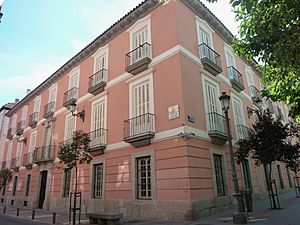Palace of the Marquis of Molins facts for kids
Quick facts for kids Palace of the Marquis of Molins |
|
|---|---|
| Native name Spanish: Palacio del Marqués de Molins |
|
 |
|
| Location | Madrid, Spain |
| Official name: Palacio del Marqués de Molins | |
| Type | Non-movable |
| Criteria | Monument |
| Designated | 2004 |
| Reference no. | RI-51-0011145 |
| Lua error in Module:Location_map at line 420: attempt to index field 'wikibase' (a nil value). | |
The Palace of the Marquis of Molins (in Spanish: Palacio del Marqués de Molins) is an old building in Madrid, Spain. It was built in the 1800s. This palace used to belong to a very important person named Mariano Roca de Togores. Today, the Spanish government owns it.
In the 1970s, the palace was changed. It became an extra building for the Real Academia de la Historia. This is a special group that studies history. The palace is also a protected landmark. It was named a Bien de Interés Cultural in 2004. This means it is a very important historical site.
Contents
About the Palace of Molins
The Palace of the Marquis of Molins is a beautiful building. It is located in the heart of Madrid. The palace shows the style of architecture from the 1800s. It has been a part of Madrid's history for a long time.
Who Was the Marquis of Molins?
The first owner of the palace was Mariano Roca de Togores. He was known as the 1st Marquis of Molins. A marquis is a noble title, like a duke or a count. He was an important person in Spain. He was a writer, a politician, and a diplomat. He lived in this grand palace.
What is a Bien de Interés Cultural?
A Bien de Interés Cultural is a special protection. It means "Property of Cultural Interest." The Spanish government gives this title to important places. These places can be buildings, monuments, or historical sites. It helps to keep them safe and preserved. The Palace of the Marquis of Molins got this title in 2004. This shows how important it is.
The Palace Today: A Center for History
Today, the palace is not a home anymore. It is used by the Real Academia de la Historia. This group studies and teaches about Spanish history. The palace helps them with their important work. It serves as an annex, meaning an extra building. It provides more space for their activities. This includes research, meetings, and keeping historical records.
See also
 In Spanish: Palacio del Marqués de Molins para niños
In Spanish: Palacio del Marqués de Molins para niños

